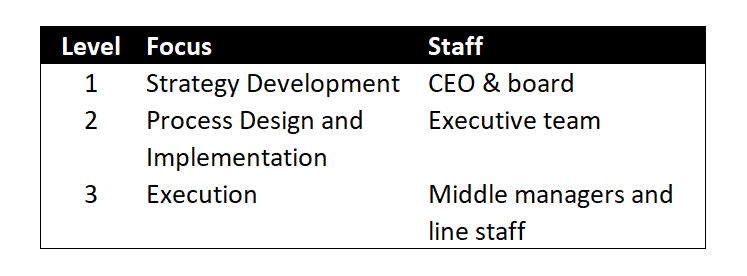Overview
Clients in need of change management expertise often rightly focus on the immediate tasks of defining the challenge, developing an appropriate process, and successfully implementing change. However, this focus is a perfect example of clients implicitly assuming that perhaps the most difficult aspect of a change management initiative will be a success: that the change initiative will have sufficient momentum to sustain itself once the outside advisors go home. This happy outcome does not happen by accident; rather, it must be an explicit focus of every change management initiative from the very beginning. Change Management professionals are catalysts for hire, but in order to be maximally effective, they must give careful thought to both the “change” and “management” portions of their role, and not lose sight of the fact that optimal client value is created when those two portions are in alignment.
Ensuring that a change management initiative becomes self-sustaining requires an understanding of the differing areas of focus among employees as well as the multiple organizational roadblocks that could rob a promising initiative of momentum. By paying careful attention to the motivations of various stakeholders, and the challenges they face, change management professionals can increase the odds of their own change initiatives reaching escape velocity and becoming a self-sustaining change within an organization.
Roles and Responsibilities
The most important voice at the table is often the one that is missing. In change management engagements there is often ample representation among leaders charged with strategy development (the board and CEO) and those charged with process design and implementation (the executive team). The missing voice, however, and the one most crucial to sustaining change, is that of the execution team (middle management and line staff). Change management professionals must recognize and attend to the fact that the constituency with the greatest ability to ensure the long-term success of a project is also the one least likely to be represented in the decision-making process.
By its very nature, a successful change management initiative will straddle multiple levels of an organization. Employing a simple 3-level taxonomy for company employee focus (see Exhibit A) can help change management professionals honor the maxim of Augustine of Hippo to “hear the other side”, and so gain insight into how best to sustain the change that they seek to catalyze by effectively navigating the respective areas of focus of employees at differing levels of an organization.
Exhibit A: Company Employee Focus by Level

- Level 1. The key to self-sustaining change for level 1 employees will be how clearly the change initiative ties to existing strategic goals. Does the change initiative logically follow from a reading of the strategic plan? If not, what is the disconnect? CEOs are under constant pressure from boards, investors, and other external stakeholders to execute on a plan, and the level of support that a change management initiative receives in the long-term may very well be tied to how clearly a change initiative adheres to a company’s existing strategy.
- Level 2. Ensuring self-sustaining change with this constituency may be an exercise in an initiative design and implementation plan that is focused on a clean hand-off. Too many consultants develop tools, processes, and plans that implicitly assume the expertise of the consultant. Self-Sustaining change assumes that the consultant is the first resource to drop off, and that the it is the level 2 employees who will own the refinement and implementation of the initiative going forward.
- Level 3. These employees are the hidden resource that many of the most successful change management professionals draw on to ensure the longevity of their work. I call them my “guardians of change”. Simply put, these are the employees whose lives must be improved by the change initiative for it to have any hope of being enthusiastically adopted (and potentially defended if challenged by level 1 or level 2 employees in the future).
Influence Model
In a recent piece on change management, McKinsey outlined a four-part influence model that has proven to be a valuable tool for many change practitioners. McKinsey found that change initiatives were most successful when each of these four components was robustly addressed in a change initiative.
- Role Modeling. Employees observe changes in the behavior of leaders, colleagues and staff.
- Understanding and Conviction. Employees understand what is being asked of them and agree with the underlying logic.
- Talent and Skills. Employees have or are on track to acquire the skills necessary to do what is being asked of them.
- Employees recognize that what they are being asked to do is supported in the organization.
In many ways the McKinsey influence model encodes and distills the hard-won lessons of change management professionals everywhere. Change does not stand on its own. Rather, successful change initiatives are those that are reinforced through communication, explanation, training, and systems.
Conclusion
As catalysts for hire, change management professionals must grapple with their own blind spots in the constant quest to improve the value of their offerings to clients. The longevity of change initiatives is not merely a function of the logic of a particular change initiative, nor its utility or the skill with which it was designed. Rather, factors such as the varying areas of focus of different decision makers involved in the change management initiative and the degree to which organizational roadblocks to lasting change have been removed are often the difference between a well-designed change initiative that dies on the vine and a change initiative that achieves escape velocity within an organization and so becomes self-sustaining. Those in the business of selling change owe it to themselves and their clients to do everything in their power to move their initiatives into the latter category.

























